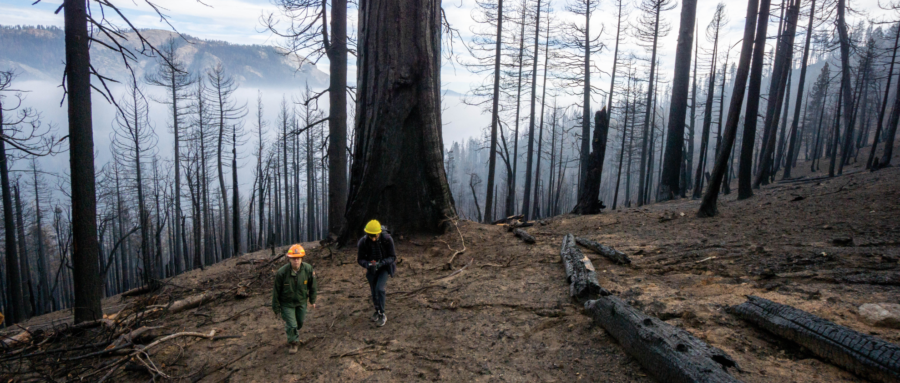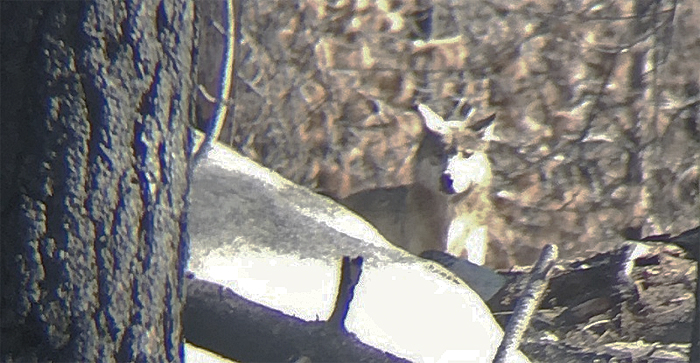Wildfires don’t “destroy” the landscapes they burn through.
Wildfires can kill trees, vegetation, and occasionally wildlife. Flames can burn down homes and businesses in towns and neighborhoods. They can even level entire city blocks.
But wildfires don’t “destroy” acres of land. More often than not, fire paves the way for something new to take root; to grow back.
A new thing has taken root in the burn scar of southern California’s 2021 Windy Fire. The lightning-caused wildfire, which burned just north of the 2016 Cedar Fire east of Porterville, burned nearly 100,000 acres of the Tule River Indian Reservation and the Sequoia National Forest, killing an estimated 3 to 5 percent of the world’s giant sequoia population.

A keystone species — an organism that helps define an entire ecosystem — is calling the fire area home again, 150 years after being hunted and driven out. A pack of gray wolves, one adult female and four cubs, has been seen in the area, according to the California Department of Fish and Wildlife (CDFW). The pack is officially the state’s southernmost wolf pack and is more than 200 miles from the nearest separate wolf pack.
“CDFW investigated the reported location, found wolf tracks and other signs of wolf presence, and collected 12 scat and hair samples from the immediate area for genetic testing,” according to the agency. “The new pack consists of at least one adult female, who is a direct descendant of California’s first documented wolf in the state in recent history.”
This image is the first photo of the pack’s adult female:

While the wolves’ return to the area is historically and ecologically significant, wolves finding home in a burn scar is reportedly a common occurrence, according to an article from Scientific American.
A lack of trees allows more sunlight to hit the soil and causes plants to sprout. The plants attract deer and other species, offering wolves ample eating opportunities. Burn scars can also act as prime den sites for wolves, with clear forests offering less obstructed views of their surroundings, intruders, and predators. And wolves aren’t the only animals to take advantage of a post-wildfire landscape.
“Other animals, such as wild turkeys, are attracted to areas soon after fire because they forage on seeds and invertebrates on the ground in the blackened areas,” said Chris Moorman, a professor of fisheries, wildlife and conservation biology at NC State University. Low-intensity prescribed fires can also increase abundance and diversity of certain plant species in forest understories.

I think the term “fire scar” is apt. Just like scars on our skin can fade and even disappear over time, the same is true following a wildfire.
The sentiment of this article is wonderful! Can I suggest a tweak to even further reduce the negative connotation surrounding wildfire? Let’s try to limit the use of ‘burn scar’ to only areas of high severity fire that are well outside the range of historic variability for patch size or frequency. Words matter, and using the idea of a ‘fire footprint’ tells the same story but without the negativity associated with a scar. Just a thought on a way to enhance the impression we leave of fire in our fire adapted landscapes.
I think you’re a little late, Kevin. The visual indication of a previous wildfire has been called a burn scar for many years, and probably won’t change because you see it as negative. The word “footprint” means something else, and it’s not a “tweak” we’re likely to make.
FIRE SCAR: (Cicatriz o herida del fuego) A healing or healed injury or wound to woody vegetation, caused or accentuated by fire; or, The overall shape and size of the area burned by a wildfire.
FIRE FOOTPRINT: (Forma del incendio) The outer shape of the fire perimeter at a given point in time. In the context of restoration, the fire footprint will be the final extent of the perimeter.
I was referring to the use of burn scar as a reference to perimeter, not fire scar in reference to injury to woody plants. You prove my point that we COULD make the cultural shift by the definitions you post having nearly the same meaning when referring to a perimeter. I know scars heal with time, but to the general audience scar has a negative connotation whereas fire footprint is value neutral and allows a wider audience to perceive the positive aspects of wildfire. Just something to consider when attempting to shift wider cultural perceptions of fire as an ecological process.
I am VERY aware that removing ‘burn scar’ from common use would take a long time. That doesn’t mean it’s a bad or flawed idea. It’s something I think could really help shift common
cultural perceptions of wildfire, so it’s a discussion worth having. I don’t just see it as negative, my experience interacting with the general public in fire and fuels management has shown me words matter and when yiou say burn scar people envision total destruction over the entire area of a fire, regardless of actual severity or the historical character of fire in a given landscape. It would take a lot to shift, but why not be a part of making the start?